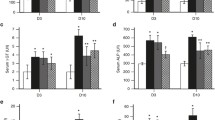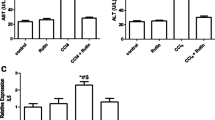Summary
The exact mechanism by which knockout of Toll-like receptor 4 (TLR4) attenuates the liver injury remains unclear. The present study aimed to examine the role of TLR4 in the pathogenesis of bile duct ligation (BDL)-induced liver cholestatic injury and the underlying mechanism. Wild type (WT) mice and TLR4 knockout (TLR4-KO) mice were used for the establishment of the BDL model. Metabolomics were applied to analyze the changes of small molecular metabolites in the serum and liver of the two groups. The serum biochemical indexes and the HE staining results of liver tissue showed that liver damage was significantly reduced in TLR4-KO mice after BDL when compared with that in WT mice. The metabolite analysis results showed that TLR4 KO could maintain the metabolisms of amino acids- and choline-related metabolites. After BDL, the amino acids- and choline-related metabolites, especially choline and 3-hydroxybutyrate, were significantly increased in WT mice (both in serum and liver), but these metabolites in the liver of TLR4-KO mice after BLD were not significant different from those before BLD. In conclusion, TLR4 KO could attenuate BDL-induced liver cholestatic injury through regulating amino acid and choline metabolic pathways.
Similar content being viewed by others
References
Oya S, Yokoyama Y, Kokuryo T, et al. Inhibition of Toll-like receptor 4 suppresses liver injury induced by biliary obstruction and subsequent intraportal lipopolysaccharide injection. Am J Physiol Gastrointest Liver Physiol, 2014,306(3):G244–G252
Ueno K, Ajiki T, Watanabe H, et al. Changes in extrathymic T cells in the liver and intestinal intraepithelium in mice with obstructive jaundice. World J Surg, 2004,28(3):277–282
Abraham S, Hermesz E, Szabo A, et al. Effects of Kupffer cell blockade on the hepatic expression of metallothionein and heme oxygenase genes in endotoxemic rats with obstructive jaundice. Life Sci, 2012,90(3–4):140–146
Brandoni A, Di Giusto G, Franca R, et al. Expression of kidney and liver bilitranslocase in response to acute biliary obstruction. Nephron Physiol, 2010,114(4):p35–40
Penkov N. Pathogenetic mechanisms in biliary obstruction (literature review). Khirurgiia (Sofiia), 2003,59(1–2):39–45
Sepehri Z, Kiani Z, Kohan F, et al. Toll like receptor 4 and hepatocellular carcinoma; A systematic review. Life Sci, 2017,179:80–87
Zare-Bidaki M, Tsukiyama-Kohara K, Arababadi MK. Toll-like receptor 4 and hepatitis B infection: molecular mechanisms and pathogenesis. Viral Immunol, 2014, 27(7):321–326
Guo J, Friedman SL. Toll-like receptor 4 signaling in liver injury and hepatic fibrogenesis. Fibrogenesis Tissue Repair, 2010,3:21
Pradere JP, Troeger JS, Dapito DH, et al. Toll-like receptor 4 and hepatic fibrogenesis. Semin Liver Dis, 2010,30(3):232–244
Tang SF, Zhao LJ. Action and mechanism of LPS/TLR4 signaling pathway in hepatolithiasis: recent progress. Chin J Gener Surg (Chinese), 2017,26(2):235–240
Nabih ES, El-Kharashi OA. Targeting HMGB1/TLR4 axis and miR-21 by rosuvastatin: role in alleviating cholestatic liver injury in a rat model of bile duct ligation. Naunyn Schmiedebergs Arch Pharmacol, 2019, 392(1):37–43
Zhao DY, Han LS, He ZJ, et al. Identification of the Plasma Metabolomics as Early Diagnostic Markers between Biliary Atresia and Neonatal Hepatitis Syndrome. PLoS One, 2014,9(1):e85694
Zhou K, Wang J, Xie G, et al. Distinct Plasma Bile Acid Profiles of Biliary Atresia and Neonatal Hepatitis Syndrome. J Proteome Res, 2015,14(11):4844–4850
Zhou K, Xie G, Wen J, et al. Histamine is correlated with liver fibrosis in biliary atresia. Dig Liver Dis, 2016,48(8):921–926
Lee P, Park HJ, Cho N, et al. 3,5-Diethoxy-3′-Hydroxyresveratrol (DEHR) Ameliorates Liver Fibrosis via Caveolin-1 Activation in Hepatic Stellate Cells and in a Mouse Model of Bile Duct Ligation Injury. Molecules, 2018,23(11):2833
Xie B, Liu A, Zhan X, et al. Alteration of gut bacteria and metabolomes after glucaro-1,4-lactone treatment contributes to the prevention of hypercholesterolemia. J Agric Food Chem, 2014,62(30):7444–7451
Mickiewicz B, Vogel HJ, Wong HR, et al. Metabolomics as a novel approach for early diagnosis of pediatric septic shock and its mortality. Am J Respir Crit Care Med, 2013,187(9):967–976
Amathieu R, Triba MN, Nahon P, et al. Serum 1H-NMR metabolomic fingerprints of acute-on-chronic liver failure in intensive care unit patients with alcoholic cirrhosis. PLoS One, 2014,9(2):e89230
Yu MJ, Xiang TX, Wu XP, et al. Diagnosis of acute pediatric appendicitis from children with inflammatory diseases by combination of metabolic markers and inflammatory response variables. Clin Chem Lab Med, 2018,56(6):1001–1010
Yin PY, Wan DF, Zhao CX, et al. A metabonomic study of hepatitis B-induced liver cirrhosis and hepatocellular carcinoma by using RP-LC and HILIC coupled with mass spectrometry. Mol Biosyst, 2009,5(8):868–876
Zheng P, Gao HC, Li Q, et al. Plasma Metabonomics as a Novel Diagnostic Approach for Major Depressive Disorder. J Prot Res, 2012,11(3):1741–1748
Mamtimin B, Xia G, Mijit M, et al. Metabolic differentiation and classification of abnormal Savda Munziq’s pharmacodynamic role on rat models with different diseases by nuclear magnetic resonance-based metabonomics. Pharmacogn Mag, 2015,11(44):698–706
Li M, Yin L, Liu P, et al. LPS increases the liver injury viaTLR4 dependent manner in mice with acute obstructive jaundice. J Hepatobiliary Surg, 2010,18(3):224–227
Zhu J, Lu T, Chen F, et al. Choline Protects Against Intestinal Failure-Associated Liver Disease in Parenteral Nutrition-Fed Immature Rats. JPEN J Parenter Enteral Nutr, 2016:148607116677048
Yamamoto H, Kanno K, Ikuta T, et al. Enhancing hepatic fibrosis in spontaneously hypertensive rats fed a choline-deficient diet: a follow-up report on long-term effects of oxidative stress in non-alcoholic fatty liver disease. J Hepatobiliary Pancreat Sci, 2016,23(5):260–269
Sherriff JL, O’Sullivan TA, Properzi C, et al. Choline, Its Potential Role in Nonalcoholic Fatty Liver Disease, and the Case for Human and Bacterial Genes. Adv Nutr, 2016,7(1):5–13
Mikami D, Kobayashi M, Uwada J, et al. β-Hydroxy-butyrate, a ketone body, reduces the cytotoxic effect of cisplatin via activation of HDAC5 in human renal cortical epithelial cells. Life Sci, 2019,222:125–132
Du X, Liu G, Loor JJ, et al. Impaired hepatic autophagic activity in dairy cows with severe fatty liver is associated with inflammation and reduced liver function. J Dairy Sci, 2018,101(12):11 175–11 185
Chang Z, Wang H, Li B, et al. Metabolic Characterization of Peripheral Host Responses to Drainage-Resistant Klebsiella pneumoniae Liver Abscesses by Serum 1H-NMR Spectroscopy. Front Cell Infect Microbiol, 2018,8:174
Lamontagne RJ, Casciano JC, Bouchard MJ. A broad investigation of the HBV-mediated changes to primary hepatocyte physiology reveals HBV significantly alters metabolic pathways. Metabolism, 2018,83:50–59
Yang W, Zhou G, Zou S, et al. Metabonomics of d-glucaro-1,4-lactone in preventing diethylnitrosamine-induced liver cancer in rats. Pharm Biol, 2018,56(1):643–648
Author information
Authors and Affiliations
Corresponding author
Ethics declarations
The authors declare that there is no conflict of interest with any financial organization or corporation or individual that can inappropriately influence this work.
Additional information
This study was supported by the National Natural Science Foundation of China (Nos. 81960101; 81860483).
Rights and permissions
About this article
Cite this article
Zhang, Sh., Yu, Mj., Yan, Jl. et al. TLR4 Knockout Attenuates BDL-induced Liver Cholestatic Injury through Amino Acid and Choline Metabolic Pathways. CURR MED SCI 41, 572–580 (2021). https://doi.org/10.1007/s11596-021-2364-8
Received:
Accepted:
Published:
Issue Date:
DOI: https://doi.org/10.1007/s11596-021-2364-8




